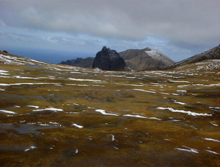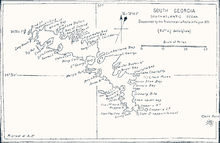Anthony de la Roché
Anthony de la Roché (* in London ; also known as Antoine de la Roché , Antonio de la Roché or Antonio de la Roca ) was an English trader . His father was a French Huguenot and his mother was English. In 1675, on a business trip from South America to Europe, he went off course in a storm, came to South Georgia and made the first land discovery south of the Antarctic Convergence .
Discovery of South Georgia
After La Roché had acquired a 350-ton ship in Hamburg and obtained permission from the Spanish authorities to trade in Hispanic America , he reached the Canary Islands in May 1674 and the port of Callao in the Viceroyalty of Peru in October by passing through the Le Maire Strait and around Cape Horn . On his way back from Chiloé to Salvador da Bahia in April 1675, he circled Cape Horn again and was then surprised by a storm in the difficult waters of the Isla de los Estados . He was unable to reach Le Maire Street, as desired, or to circling the eastern extremity of Isla de los Estados, instead he was driven far to the east. Eventually he found shelter in one of the southern bays of South Georgia - according to some experts possibly in Drygalski Fjord - where the ship was anchored for two weeks.
According to the story published shortly after the event, La Roché found "a bay in which they anchored near a cape that extends (...) to the southeast". The surrounding glaciated area was described as "snow mountains near the coast, with a lot of bad weather". When the weather improved, the ship set sail, and as they circled the southern extremity of South Georgia, the Clerke Rocks were sighted further to the southeast.
Captain James Cook was aware of the discovery of La Roché, he mentioned it in his ship's journal while South Georgia was approached in January 1775 to make the first landings, to take possession of them for the United Kingdom and to draw up a first map of the island.
Early landing on Gough Island
A few days after leaving South Georgia , La Roché and his crew sailed to another uninhabited island "where they found water , wood and fish " and spent six days "without seeing anybody," which, according to some historians, the first landing was made on the South Atlantic Gough Island , which was discovered in 1505 or 1506 by the Portuguese navigator Gonçalo Álvarez and was then still called Diego Alvarez (until 1731).
La Roché reached the Brazilian port of Salvador and finally arrived in La Rochelle , France , on September 29, 1675 .
Maps showing La Roché's discovery
Soon after the trip, cartographers began to mark “Roché Island” and “Straits de la Roche”, which separated the island from an unknown land in the southeast, in honor of the discoverer. Most notably, the newly discovered land appeared on the following 17th century maps:
- L'Isle, Guillaume de; J. Covens & C. Mortier. (1700/20). L'Amerique Meridionale . Paris.
- Chatelain, Henry A. (1705/19). Nouvelle Carte de Geographie de la Partie Meridionale de la Amerique . Amsterdam.
- L'Isle, Guillaume de & Henry A. Chatelain. (1705/19). Carte du Paraguai, you chili, you Detroit de Magellan . Paris.
- Lens, Bernard & George Vertue. (around 1710). Map of South America . London.
- Price, Charles. (ca.1713). South America corrected from the observations communicated to the Royal Society's of London and Paris . London.
- De Fer, Nicolas. (1720). Partie La Plus Meridionale de L'Amerique, ou se trouve Le Chili, Le Paraguay, et Les Terres Magellaniques avec les Fameux Detroits de Magellan et de le Maire . Paris.
- Homann Heirs. (1733). Typus Geographicus Chili a Paraguay Freti Magellanici . Nuremberg.
- Minor, Herman. (1736). A map of Chili, Patagonia, La Plata and ye South Part of Brasil . London.
- L'Isle, Guillaume de & Girolamo Albrizzi. (1740). Carta Geografica della America Meridionale . Venice.
- Seale, Richard W. (ca.1745). A Map of South America. With all the European Settlements & whatever else is remarkable from the latest & best observations . London.
- Cowley. (ca.1745). A Map of South America . London.
- Gibson, John. (1753). South america . London.
- Jefferys, Thomas . (1768). South america . London.
The second map of South Georgia ever created was drawn in 1802 by Captain Isaac Pendleton of the US seal hunter Union and reproduced by the Italian polar cartographer Arnaldo Faustini in 1906. It was titled South Georgia: Discovered by the French La Roché in 1675 . (Pendleton was wrong about La Roché's nationality, probably because of his French surname.)
Honors
Roché Peak , the highest point on Bird Island , is named after Anthony de la Roché.
See also
| personal data | |
|---|---|
| SURNAME | Roché, Anthony de la |
| ALTERNATIVE NAMES | Roché, Antoine de la; Roché, Antonio de la; Roca, Antonio de la |
| BRIEF DESCRIPTION | English dealer |
| DATE OF BIRTH | before 1674 |
| PLACE OF BIRTH | London |
| DATE OF DEATH | after 1675 |





